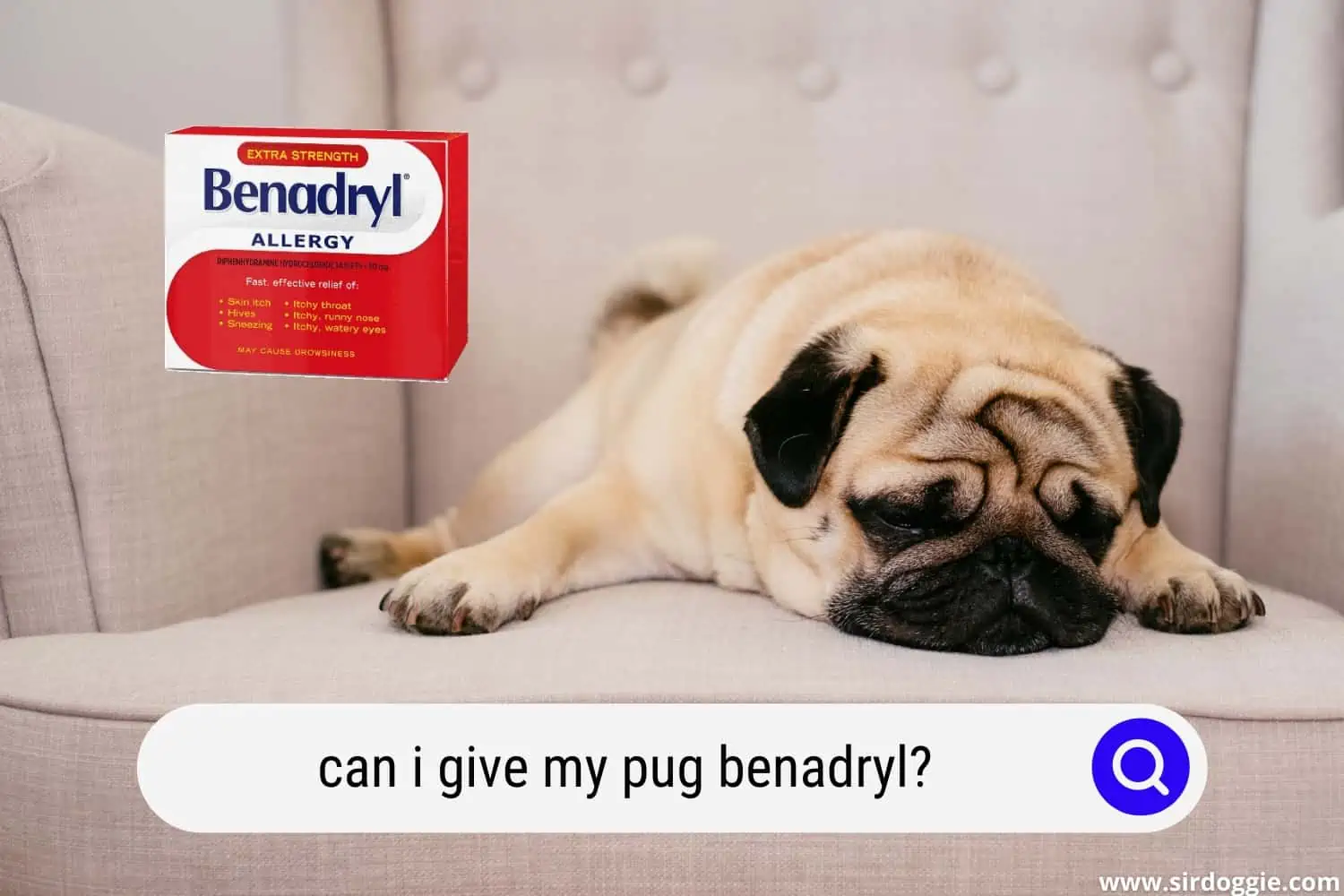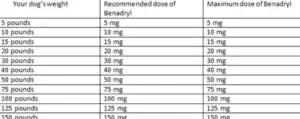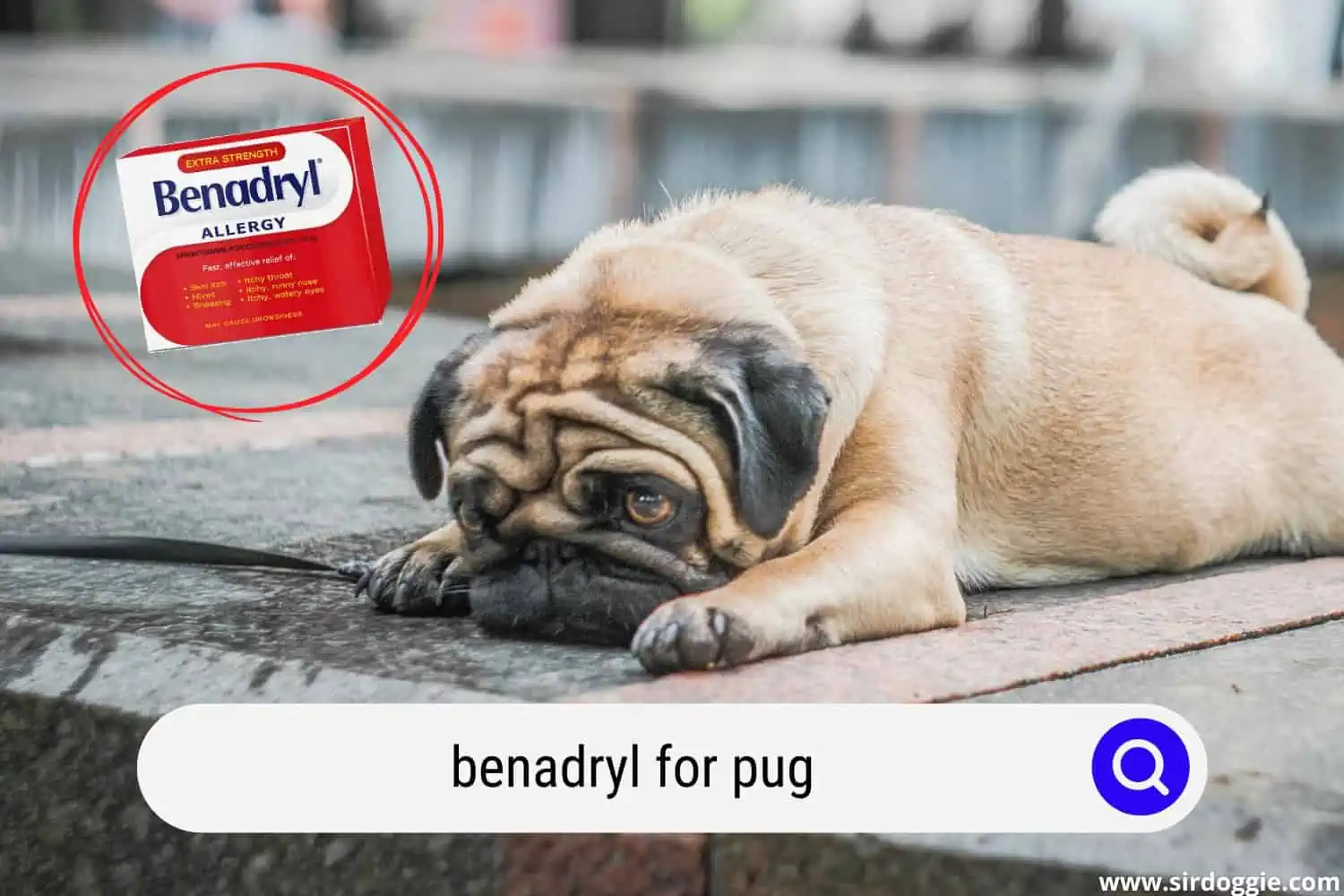Can I Give My Pug Benadryl? Learn About 7 Pug Allergy Types and Whether Benadryl Can Help
Anybody who has a Pug knows that they get similar and in some instances the same types of ailments as humans. This is true about any canine species, not just flat-faced breeds. Hence, one may think that he/she can administer the same medications to a pooch that are prescribed to humans. However, this is not always true. A dog owner might be wondering “Can I give my Pug Benadryl?” if a mutt is suddenly having an allergy attack or was bitten by an insect like a bee or wasp.
Pets cannot take a lot of meds that are intended for two-legged consumption since they can worsen an existing condition or even become toxic! Let’s take a look at Benadryl as an example to see if it can be administered to the four-legged without any serious consequences. Especially since Pugs in particular are predisposed to have allergies to anything and everything. We will cover some of the Pug allergies right below.

Pug Allergy Types
- Food Allergies: very common among our smushy-faced companions. Any new foods (besides dry ones Pugs are accustomed to) should be carefully introduced, one step at a time. Some of the widely-known canine allergens include dairy products, citrus fruits like oranges and lemons, sugar substitute Xylitol, raisins, cherries, and bulbous plants like onions and garlic. In case your pet is allergic to one of those, you will see an immediate reaction: extreme itchiness, facial/eye swelling, vomiting, diarrhea, and weakness.
- Insect Bite Allergies: humans get those a lot. Hounds are no exception to the rule. People become excited to come outside after a long winter, but spending time outdoors means dealing with emerging insects like mosquitos, flies, bees, and wasps. The last two are especially dangerous as their venom can trigger a severe allergic reaction. It is very hard to shield your beloved pooch from those nasty bugs when it gets hot out. However, what you can do is apply some insect-fighting spray all over your fur baby’s coat for protection. Also, you can look into buying a pet-safe bug repellent for your yard to eliminate the annoying insect problem.
- Dust Mite Allergies: surprisingly, pets can get allergic to dust that is found in every home. If that’s the case with your pooch, you will notice it breathing heavily, scratching its eyes to the point of bleeding and/or infection, sneezing, and coughing uncontrollably. This type of allergy can be easily treated without pills. The best solution would be to regularly dust your place, air it out, and vacuum the carpets which can also harbor dust mites in abundance.
- Pollen Allergies; go hand-in-hand with the aforementioned bug issue. Once flowers start blooming in the springtime, their pollen ends up everywhere in the yard and in the air, your pet breathes. This fact can trigger a massive reaction that in some severe cases would require medical intervention. If you happened to be an avid gardener and an aspiring florist, you wouldn’t want to consider the idea of getting rid of all your beautiful plants and blooms. Instead, you can consult with your mutt’s veterinary specialist to see if there’s anything a dog can take to control allergy outbursts.
- Parasite Allergies: those are not any better (and in some instances are worse) than the striped flying bugs we mentioned above. Ticks, as well as fleas, come out as soon as it gets warm out and start preying on our poor four-legged victims. You can see how your Pug’s skin becomes extremely irritated, as well as flaky and itchy once infested. It is best to prevent a problem rather than deal with its aftermath. Turn to parasite-repellent collars, sprays, and shampoos.
- Household Cleaners Allergies: bleach, ammonia, formaldehyde, and other chemical-based cleaners can very easily trigger an allergic reaction in your Pug pet. It is best to crate and/or isolate it somewhere while you are cleaning so it won’t have access to those harmful substances. Even after you are done cleaning your living space, make sure that all the surfaces including floors are dry before you let your pal out. One single lick can be very dangerous, to the point of anaphylactic shock.
- Medication Allergies: as we already mentioned above, dogs cannot always take the same medications as their human masters. Some may do more harm than good by being extremely toxic and lead to a lethal outcome if ingested. Sometimes a pet can take his exploring abilities too far and get into the first aid kit taken it is easily accessed. In this case, an owner pays the price for being negligent. Always hide everything that can be potentially harmful to your bundle of joy, hence it won’t be tempted to get into trouble. Now, a pooch owner whose Pug is always allergic to everything may be wondering “Can I give my Pug Benadryl?” We’ll dig into it shortly after we discuss this anti-allergy medication’s properties.
Related Reading: Pug’s Skin Rashes: Common Types and What To Do About Them
Benadryl: What Kind of Medication Is It?
Benadryl is considered an antihistamine: it fights off symptoms like itching, runny eyes, sneezing, coughing, and/or vomiting. Even though it is not an FDA-approved medication for veterinary use, many animal health professionals use it in their practices to help the allergic four-legged recover quickly. It is considered generally safe for animal consumption. However, each pet is different, hence it is imperative to discuss the possibility of administering Benadryl with a vet. The way it works is that it blocks the “bad stuff” in a canine’s body that histamines are trying to overcome and slowly relieves annoying allergy symptoms.
Can I Give My Pug Benadryl?
In case the question of “Can I give my Pug Benadryl” was lurking in your head for a while, we are about to discuss it right now.
Technically, you can give your pooch this antihistamine medication only with the vet’s approval. It is best to administer it slowly, half a dose at a time since there’s always a possibility of Benadryl dog allergy taking place. If you see your Pug’s health condition worsen after you have given out the above-mentioned pill, call your veterinary professional right away. If he/she is not available for an emergency appointment, then go to the nearest emergency pet hospital.

Below you will find a “How Much Benadryl Can I Give My Dog Chart” that will help you determine the right dosage for your precious flat-faced pooch. According to the chart, you have to go by a dog’s weight to find the right amount.

Curl-Up
If you have an allergy-prone pooch like a Pug, you are probably tempted to give it Benadryl at the first sign of a worsening health condition. However, please, go by what your trusted vet says. Don’t try to act like your mutt’s vet if you don’t know whether your actions are going to backfire or not. Familiarize yourself with the chart above to know how much of the med you can give to your pal without any danger.
Related Reading: Older Pug and Health Problems’ Symptoms: How Senior Pugs Are Affected By The “Golden Age”

Family Dog Expert Author
Hi there! I’m Stuart, a devoted dog lover and family dog expert with over a decade of experience working with our furry companions. My passion for dogs drives me to share my knowledge and expertise, helping families build strong, loving bonds with their four-legged friends. When I’m not writing for SirDoggie, you’ll find me hiking, playing with my beautiful dog, or studying music.